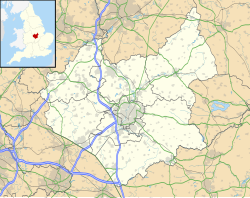This article possibly contains original research .(October 2023) |
| Eastwell | |
|---|---|
 St Michael and All Angels, Eastwell | |
Location within Leicestershire | |
| Civil parish | |
| District | |
| Shire county | |
| Region | |
| Country | England |
| Sovereign state | United Kingdom |
| Post town | Melton Mowbray |
| Postcode district | LE14 |
| Police | Leicestershire |
| Fire | Leicestershire |
| Ambulance | East Midlands |
| UK Parliament | |

Eastwell is a village and ecclesiastical parish [1] in Leicestershire, England.
Contents
The village's name means 'eastern spring/stream'. [2] [3]
For the purposes of administration Eastwell is part of the civil parish of Eaton that, in turn, forms part of the borough of Melton. [4] Eastwell lost its own civil parish status on 1 April 1936. Its population in 1931 was recorded as 152; [5] the 1851 census had recorded 158 [6] so the village had not suffered the rural depopulation seen elsewhere. There are 67 occupied dwellings in 2021 within the main village of Eastwell.
Further back in time:
Eastwell is in the Hundred of Framland, 6 miles north by East from Melton; contains 1291 acres, 109 inhabitants and 24 acres. The sole proprietor is the duke of Rutland, who has a seat called Eastwell Hall. Lord Huntingtower is lord of the manor. The king is patron of the rectory, which has a glebe of 36 acres. The rector receives 85 pounds yearly in lieu of tithes.
— Curtis's History of Leicestershire. 1830 [7]
Eastwell Church (St Michael) is built of ironstone. It dates mostly from the thirteenth century. [8]
From the early 14th century to the mid 16th century, Eastwell was the seat of one branch of the Brabazon family.
The Hall is a Grade II* listed building [9] It dates from 1634 but has windows and a front door altered in the nineteenth century. [10]
Eastwell Village Hall was re-built and opened in 2015 and hosts a variety of community events including a weekly community pub, exercise classes and live music events. [11]
